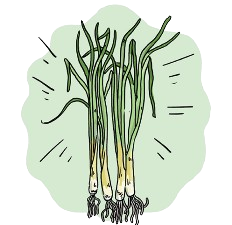Learn to grow microgreens at home, join Grow It Local +
How to grow
Join Our Community
Learn to grow and cook healthy, delicious, organic food at home by joining our seasonal grow-alongs.
Join Our Community
Learn to grow and cook healthy, delicious, organic food at home by joining our seasonal grow-alongs.
Growing Tips and Tricks
Location:
Spring onions prefer a location with full sun to partial shade. They can tolerate a range of soil types but prefer well-draining, fertile soil. Spring onions can be grown throughout the year, but they thrive in cooler weather and can tolerate light frosts.
Watering:
Spring onions require consistent moisture for even growth. Keep the soil evenly moist but not waterlogged. In hot weather, you may need to water more frequently, but in cooler weather, watering once or twice a week should be sufficient.
Problems:
Pest Control: Watch out for common pests such as onion flies and thrips. Use row covers and keep your plants nice and healthy to protect the plants from infestations.
Diseases: Spring onions are generally disease-resistant, but ensure good air circulation to prevent fungal issues.
Bolting: Spring onions can bolt and produce flowers prematurely in response to heat or other stress factors. To prevent bolting, plant spring onions in cooler weather.
Overcrowding: Avoid overcrowding the spring onion plants, as this can lead to competition for nutrients and affect their growth.
Harvest:
Spring onions can be harvested once they have reached a usable size, typically about 15-20 cm in height. You can harvest the green tops and white bottoms together or snip individual leaves as needed. Regular harvesting promotes continuous growth.
Background
A close relative of onions and garlic, Spring onions were highly valued by ancient civilizations such as the Egyptians, Greeks, and Romans. This popularity saw them spread around the world as trade and exploration expanded.
They have been used in China since ancient times as a kind of culinary disinfectant, added to stews to dispel raw meaty flavours of meat, fish and seafood.
They are considered so special in China that there was once a tradition of sending a child for their first day of school with a bunch of spring onions to bring good luck.
The name ‘spring onions’ comes from their characteristic of being harvested in the springtime when they are young and tender. Unlike regular onions, which develop a bulb, spring onions consist of two parts — the small white bottoms and the long hollow green shoots on top. Both are edible.
Health Benefits
Homegrown, organic snow peas are good for you!
They contain vitamins (A, C, K) and minerals (folate and potassium).
Consuming spring onions can support immune function, vision, and bone health due to their vitamin content. They are also a good source of antioxidants, such as quercetin, which help protect against oxidative stress and inflammation.
Spring onions also contain prebiotic fibres, which support gut health by promoting the growth of beneficial gut bacteria.
Patch to plate
Spring onions are one of the most versatile members of the onion family. Milder than a regular onion, they can be eaten fresh or cooked, you can use the green part, the white part or both! Here’s a couple of ideas on how to use your delicious homegrown spring onions…
- With potato, dill and cheese in a delicious frittata
- Served with BBQ’d fish, chilli and lime
- Charred and served with olives and rice as a delicious salad




